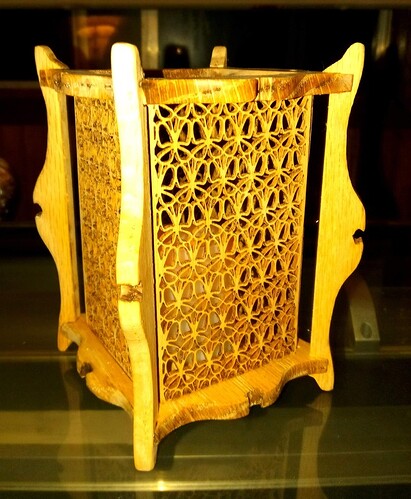GerardA
November 22, 2022, 3:05am
1
Anyone have any great ways to conceal the edges where two flat wood pieces join?
evansd2
November 22, 2022, 3:38am
2
You might like these two threads:
THERE ARE PICTURES DOWN BELOW! Don’t run away because of all the dumb text finger joint roundup , I had a few rules I set up at first to keep the scope manageable.
No more than two species of wood involved.
No “islands”. All wood needed to be firmly attached to its “side” of the joint
Light, constant kerf cor…
Finger joints are practical and boring. Rather than fighting against them as a constraint, I tried to imagine them as design elements. I only had one general rule: Anything added should actually be part of the joint. This is about finger joints, not inlay projects. This is what I came up with.
The techniques came in a few varieties:
Obscured: I tried to implement them in a way that would minimize or distract from the inherent blockiness.
Highlighted: Run toward the light. Incorporate …
Both talk about that sort of thing.
8 Likes
If you can’t hide it - accentuate it. Make it a feature.
9 Likes
PrintToLaser:
If you can’t hide it -
What you can’t hide, Flaunt. A very famous rule…
Light up a room and surfaces with an awe inspiring 3D Helix pattern. Excellent for coffee table, dining table, or bedroom. It can create years of enjoyment, and LED means the extra safety of no actual flame involved. Fits 3"x3" or 3"x4" LED...
Price: USD 7.99
8 Likes
Doppler
November 22, 2022, 4:38am
5
I haven’t tried it yet, but mitered edges are on my experimental To Do list.
Some of you may remember the teaser I posted a few days ago about miter cuts on the Glowforge. I finally scraped together enough “me” time to finish the project. I’ve been working on it a long time! (@marmak3261 saw parts of it when he visited last week). First, the finished project, then I’ll show the progress photos in case anybody is interested in trying something similar.
[image]
[image]
Total height is 4.25" and the “stained glass” panels are 2" each side including the walnut corners…
2 Likes
Then again you can avoid edge connections completely…
4 Likes
Doppler
November 22, 2022, 4:45am
7
For 90-degree angles, acrylic facades work great.
2 Likes
Aloha
November 22, 2022, 6:34am
8
I really like this double helix design!!! Great work!
2 Likes
There are several more “in the hopper” though one is very fishy.
2 Likes
Well, I no longer have to play coy.
1 Like
Aloha
November 25, 2022, 5:42pm
11
Hahahahaha punny.
1 Like
Aloha
November 25, 2022, 5:45pm
12
my
1 Like
1 Like
Aloha
November 25, 2022, 5:54pm
14
I have completed designs, however, I can’t test betas. For example, I have some leather stitch holes, and no way of determining if they are spaced correctly, the correct distance, etc.
We need a regional Glowforge parts distribution center for Hawaii
3 Likes
Aloha
November 25, 2022, 6:09pm
18
You are getting fishy again
2 Likes
Back to the op.
system
December 26, 2022, 1:40pm
20
This topic was automatically closed 30 days after the last reply. New replies are no longer allowed.
![]()
![]() is still broken waiting for a part… so I’m just looking at things that I can’t make.
is still broken waiting for a part… so I’m just looking at things that I can’t make.
![]()
![]()
![]()
![]()
![]()
![]() captain.
captain.

